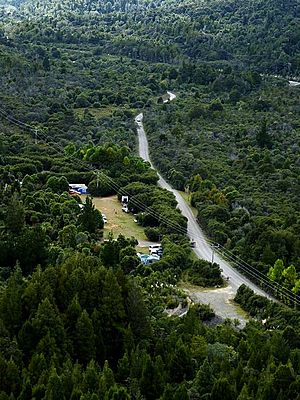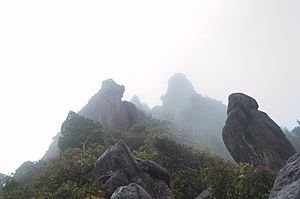Kauaeranga Valley facts for kids
Quick facts for kids
Kauaeranga Valley
|
|
|---|---|

View from a campsite of the Kauaeranga Valley
|
|
| Country | |
| Region | Waikato |
| Territorial authority | Thames-Coromandel District |
| Ward | Thames Ward |
| Population
(2018)
|
|
| • Total | 588 |
The Kauaeranga Valley is a beautiful valley in New Zealand. It was formed by the Kauaeranga River. This river flows from the Coromandel Range all the way to the Firth of Thames near Thames, New Zealand. The main road in the valley is called Kauaeranga Valley Road.
The Kauaeranga Visitor Centre is a great place to start your adventure. It's run by the Department of Conservation. Here, you can pay for camping spots or book a stay at one of the two cottages. The centre is about 13 kilometers from Thames. The road is paved up to this point, then it becomes a gravel road for the last 9 kilometers. Many short walks and longer hikes begin from the road past the centre.
One popular hike is The Pinnacles Walk. This trail starts at the end of Kauaeranga Valley Road. It leads to the top of a volcanic peak, which is 759 meters high. The round trip usually takes about eight hours. Some people choose to do it over two days.
For those doing multi-day hikes, there are two huts for overnight stays. Pinnacles Hut has 80 bunks, and Crosbies Hut has 10 bunks. These huts offer basic shelter for hikers.
Contents
Valley History and Heritage
The local Māori tribe, Ngāti Maru, had a special name for this area. They called it Waiwhakauaeranga. This name means "waters of the stacked jaw bones." It was a way to remember a battle where they piled up the jaw bones of their enemies.
Kauri Timber and Early Industries
The valley was once full of kauri trees. These trees were a valuable source of timber. In the late 1800s and early 1900s, many dams and tramlines were built. These helped to move the huge kauri logs out of the valley.
Some farms were started in the valley around 1880. But farming was very hard because of the lack of good roads and tough weather. So, much of the land eventually went back to being natural bush. By the late 1960s, not much farmland was left.
Schools and Services
People living in the valley first asked for a school in 1896. The Kauaeranga Valley School finally opened in 1903. It started with 30 students. By 1946, the number of students dropped to just seven. This was because the road to Thames had improved, and many children went to school there instead. The school then closed.
A post and telegraph office opened in 1903. It closed in 1953, and mail was delivered directly to homes after that. A telephone office stayed open until 1955. After that, an automatic telephone system made it unnecessary.
The Kauaeranga Valley Dairy Company opened a factory in November 1907. They made milk and butter. But it closed quickly in September 1908. The company then moved to another town and stopped operating by 1910.
Roads and Infrastructure
In 1909, there was a plan to build a road between Thames and Tairua. The suggested path went through the Kauaeranga Valley. A track was made along this route in 1926. The next year, 100 men started to build a road, but the work stopped later that year.
After the Second World War, a different route was chosen. This new road, now known as State Highway 25A, was built from 1961. It opened in March 1967.
From 1957, an electric power line was built. It went from Thames, through the Kauaeranga Valley, and north to Coroglen. This project was finished by 1959.
Protecting Nature
In 1970, the Coromandel Forest Park was created. This park was made to protect the remaining native forests. It also took over the old farmland in the valley.
Population and Community Life
| Historical population | ||
|---|---|---|
| Year | Pop. | ±% p.a. |
| 2006 | 531 | — |
| 2013 | 564 | +0.87% |
| 2018 | 588 | +0.84% |
In 2018, Kauaeranga had a population of 588 people. This was an increase of 24 people since 2013. It was also an increase of 57 people since 2006. There were 207 homes in the area.
There were slightly more males (294) than females (291). The average age was 48.6 years old. About 17.3% of the people were under 15 years old. Around 21.9% were 65 years or older.
Most residents (88.3%) were of European/Pākehā background. About 18.9% identified as Māori. People could choose more than one ethnicity.
About 15.3% of the people were born outside New Zealand. This is less than the national average of 27.1%.
When asked about religion, 62.2% said they had no religion. About 26.5% were Christian. A small number followed other religions like Hindu or Buddhist.
For those aged 15 and older, 21.6% had a university degree or higher. About 17.9% did not have formal qualifications. The average income was $28,900. Many people worked full-time (45.7%) or part-time (19.8%). A small number (3.1%) were unemployed.


